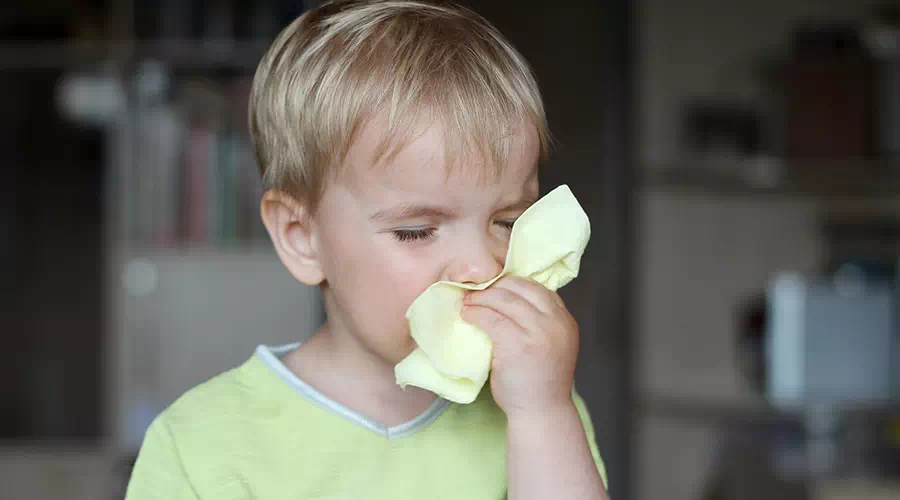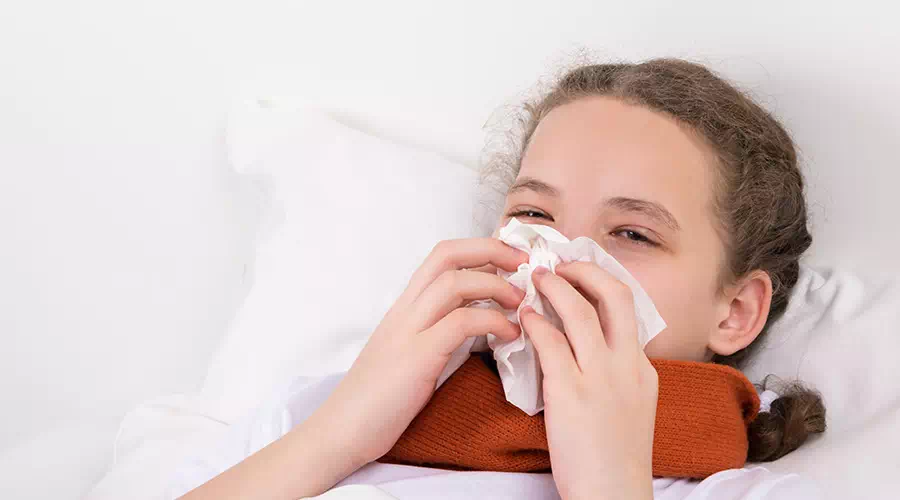Allergic rhinitis, as its name implies, is naturally related to allergic reactions. Allergic reaction is a kind of allergic reaction of the body’s immune system.
After entering the human body, external substances will be identified by the body as harmful substances. If identified as harmful substances, the immune system will respond to eliminate or expel them.
However, if the immune system is too strong or [accurate enough] and the immune response to certain foreign substances exceeds the normal range, some harmless or even useful substances will be treated as harmful substances, thus causing us to have allergic reactions.
Common Symptoms of Allergic Rhinitis

Allergic rhinitis, medically known as allergic rhinitis, is a non-infectious nasal inflammatory disease mediated mainly by IgE (one of human immunoglobulins) after the body contacts allergens.
There are three conditions for allergic rhinitis:
1. Allergens
2. Individuals with allergic constitution
3. Allergic constitution individuals come into contact with allergens and trigger allergic reactions.
The common symptoms of allergic rhinitis are nasal obstruction, nasal itching, paroxysmal sneezing, runny nose and cough.
Among them, nasal itching is a characteristic symptom of allergic rhinitis. Children’s nasal itching is usually manifested as rubbing nose, picking nostrils or allergic salute in various ways.
In addition, allergic rhinitis can cause itching in the soft palate of pharynx, coupled with increased secretion of mucosal inflammation and backflow, so it is inevitable to clear throat and cough, which will occur repeatedly.
Daily Life Protection of Allergic Rhinitis

The onset of allergic rhinitis is closely related to heredity, living environment and allergen exposure. It is very difficult to cure it without attack, but through strict daily life protection and reasonable treatment, symptoms can be alleviated and improved, attacks can be reduced, and even attacks can be almost avoided.
The core of allergy protection is to avoid allergens, not to contact or reduce contact, or to reduce inhalation of allergens, and to shorten the residence time of allergens in nasal cavity.
For children with allergic rhinitis, even if they do not have relevant tests to make it clear that allergens are common allergens in what and home life, routine avoidance is recommended. For example: Dermatophagoides farinae, animal dander, pollen, smog, etc.
If allergens have been identified, such as blood drawing or skin pricking tests, and allergens have been confirmed through allergy observation, contact should be strictly avoided.
1. Children who are allergic to pollen should not go to areas with dense flowers during the pollen season.
2. If there are children who are allergic to animal fur in the family, try not to keep pets, or let children and pets be separated.
3. Frequent cockroaches at home and the components of cockroach secretions and feces are also one of the very common allergens, so it is also necessary to eliminate and kill cockroaches. In addition to keeping the home clean, professional insecticidal treatment should be carried out when necessary.
4. Secondhand smoke is a high-risk factor for allergic rhinitis, but even if there is no allergic child, the child should not be exposed to smoke.
5. Dermatophagoides farinae is a very common allergen that induces allergic rhinitis. Special attention should be paid to the fact that whether the body, secretion or excrement of Dermatophagoides farinae can cause strong allergic reactions of allergic patients.
In real life, we cannot avoid all allergens perfectly. There are always times when allergens cannot be prevented. At this time, we need to take measures to minimize the number of allergens staying in the nasal cavity and shorten the time of allergens staying in the nasal cavity.
How will the doctor treat allergic rhinitis?

Step 1: Protect against allergens in daily life.
As mentioned above, the protection method is very important. Due to the limited time of doctors, they may not speak very carefully during the usual visit, which requires them to pay attention to and learn to accumulate in their daily life.
Step 2: Nasal flushing with normal saline.
Nasal irrigation is especially important for patients with allergic rhinitis, helping to keep the nasal cavity clean, moist and unobstructed. It can remove nasal secretions and scabs, dilute nasal cavity and sinus secretions and promote their discharge, and at the same time can wash away allergens and inflammatory factors on the surface of nasal mucosa.
Before the nasal cavity needs to be sprayed, if there are more secretions in the nasal cavity, the nasal cavity needs to be flushed before spraying. Otherwise, due to the obstruction of secretions, the drug cannot directly contact the nasal mucosa, which will make the drug effect unable to exert well.
Step 3: Use drugs to relieve symptoms.
Usually doctors will use the following four types of drugs when treating allergic rhinitis according to different symptoms:
1. Intranasal Glucocorticoid Spray
Commonly used nasal spray glucocorticoids include the following:
Mometasone furoate, recommended for use at age 2 or above;
Fluticasone furoate is recommended to be used at an age of over 2 years old.
Fluticasone propionate, recommended for use over 4 years old;
Budesonide is recommended to be used over 4 years old.
Triamcinolone acetonide, recommended for use over 6 years old;
Nasal spray glucocorticoid has strong anti-inflammatory, anti-edema and anti-allergy effects, low systemic bioavailability and relatively safe local use. Parents need not worry too much about adverse reactions of hormone drugs to their children.
Blow your nose before use, clean your nasal cavity with normal saline, which can maximize the curative effect of the drug, and make the child lower his head slightly when using, so as to facilitate the excess liquid medicine to flow out of the front nostrils, so as to reduce the amount of the drug swallowed into the body.
When spraying nose, pay attention to avoid nasal septum to avoid bleeding.
The recommended course of treatment for mild allergic rhinitis is usually at least 2-4 weeks and 1-3 months for moderate and severe rhinitis. This is a step-like process of drug reduction and withdrawal. During this period, repeated follow-up visits are required. Doctors evaluate the symptoms and nasal mucosa of children, and then give treatment arrangements for reduction or withdrawal.
Don’t stop taking the drug as soon as the symptoms are relieved, otherwise it will easily lead to relapse.
2. Antihistamines
Antihistamines are divided into nasal spray and oral dosage forms.
Nasal spray antihistamines, used locally, take effect quickly, can quickly relieve nasal itching, sneezing, runny nose and other symptoms, with less systemic side effects, and can be used in combination with oral antihistamines. Common drugs include:
Levocabastine Acid, which can be used by babies over 6 months old;
Azelastine hydrochloride can be used by children over 6 years old.
Oral antihistamines are commonly used by children:
Cetirizine hydrochloride can be used by babies over 6 months old.
Loratadine, with syrup and tablets, can be used by children over 2 years old and tablets can be selected if swallowed smoothly over 4 years old.
Antihistamines Special Reminder:
The common cold does not require routine use;
Allergic rhinitis is recommended for at least 14 days.
Please follow the doctor’s advice, according to the indications and according to the course of treatment.
3. Leukotriene receptor antagonist
This is often called montelukast sodium, which is usually used for moderate to severe allergic rhinitis, allergic rhinitis complicated with high airway reaction, asthma, etc.
Special Reminder:
Not suitable for all coughs, not coughs need to eat;
The course of treatment is usually 1-3 months or even longer, please follow the doctor’s advice;
4. Nasal mucosal decongestant
Nasal mucosal decongestant is not a scourge and does not need to be afraid. Reasonable use can effectively and timely help relieve symptoms and promote treatment. The use time is 3-7 days, and the drug can be stopped for symptom relief. It is not recommended to use it for more than 7 days. Long-term use for several months may lead to drug-induced rhinitis.
Hydroxymethazoline hydrochloride is recommended for children over 2 years old.
Cilazoline hydrochloride is recommended for children over 2 years old.
The above drugs are all suitable for children over 2 years old. What about serious nasal congestion in children within 2 years old?
Children under 2 years old, or infants of younger age, will also suffer from very serious nasal congestion. The treatment methods and steps are as follows:
(1) nasal spray normal saline nasal cavity flushing, clean secretions, will not blow your nose baby, need to be combined with nasal aspirator to assist in treatment;
(2) Nasal mucosa swelling and blockage, replace with 3% hypertonic saline nasal spray;
(3) Good implementation of the above steps, nasal congestion is serious and lasts for more than 2 weeks, please see a pediatric otolaryngologist face to face;
5. Desensitization: Desensitization is the fundamental treatment for children with definite allergens.
